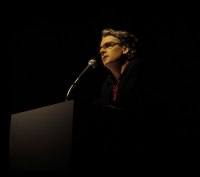Filmmaker Craig Baldwin is the first to admit that he's something of a folk artist. Despite impressive art-world credentials (he studied under Bruce Conner in the 1980s, won the 1997 Alpert Award in the Arts, and was featured in the 2000 Whitney Biennial), he prefers to use inexpensive, low-tech equipment for his work, such as 8mm cameras, kinescopes, and manual editing machines. He culls and then recontextualizes everyday footage from the airwaves and archives—TV newscasts, 1950s sci-fi movies, schlocky instructional filmstrips, and government propaganda films. Baldwin's unabashed populist tendencies are apparent in his films: Sonic Outlaws and Spectres of the Spectrum repeat a common theme of reclaiming media for the little guy. His appearance as guest panelist at the Walker’s Sins of Change: Media Arts in Transition, Again conference in April 2000 signaled the beginning of his seven-month residency at the museum, during which he brought his democratic—and decidedly subversive—media ethic to Minneapolis for a variety of activities.
In a two-week workshop in June 2000, Baldwin led a culture-jamming project for teens, overseeing the creation of found-footage films. The teen films were screened in October 2000 as part of De Facto Films, an installation of recontextualized film and discarded projection equipment curated by Baldwin in cooperation with the Walker Art Center Teen Arts Council (WACTAC) at No Name Exhibitions@The Soap Factory. The installation sought to revitalize the film-viewing experience. “When you watch it on a flat screen you just read data,” he said in a 1998 interview. . . .
In a two-week workshop in June 2000, Baldwin led a culture-jamming project for teens, overseeing the creation of found-footage films. The teen films were screened in October 2000 as part of De Facto Films, an installation of recontextualized film and discarded projection equipment curated by Baldwin in cooperation with the Walker Art Center Teen Arts Council (WACTAC) at No Name Exhibitions@The Soap Factory. The installation sought to revitalize the film-viewing experience. “When you watch it on a flat screen you just read data,” he said in a 1998 interview. . . .
Artist's Statement
"My idea is to embrace the noise of pop culture and make art out of it."—Craig Baldwin







